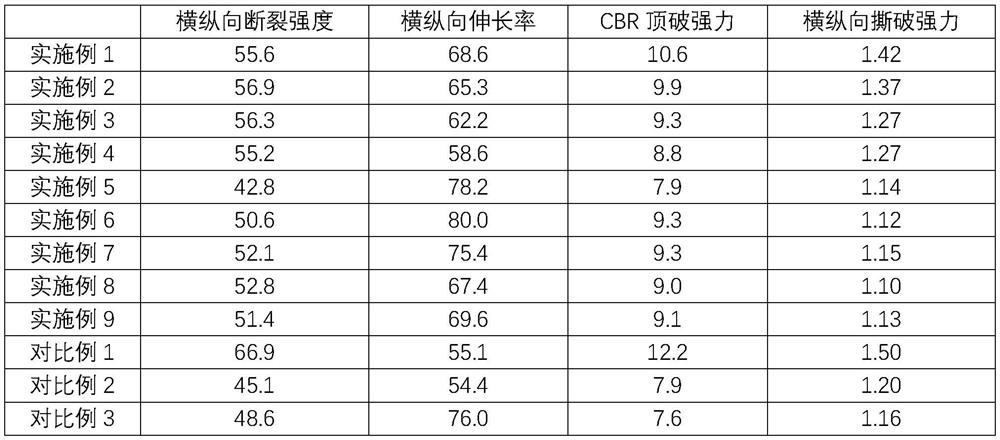Self-repairing non-woven fabric
A non-woven fabric and self-repairing technology, which is applied in the direction of non-woven fabric, fiber type, filament forming treatment, etc., can solve the problems of difficult non-woven fabrics, deterioration of silk tensile strength, clogged nozzles, etc., to improve tensile strength , better bonding effect, lower melt viscosity
- Summary
- Abstract
- Description
- Claims
- Application Information
AI Technical Summary
Problems solved by technology
Method used
Image
Examples
Embodiment 1
[0041] A preparation process of a self-healing non-woven fabric, comprising the following steps:
[0042] S1. Drying: Dry all raw materials to a final moisture content of less than 35ppm;
[0043] S2. Pretreatment: Mix 12 parts of turpentine and 4.5 parts of cuprous chloride powder evenly, send it to a colloid mill to grind into a colloid, and control the temperature not to exceed 50°C;
[0044]S3. Melting: 110 parts of PET chips, 60 parts of acrylamide-maleic anhydride-acrylic acid copolymer with a content of 30% by weight of the calibrated acrylamide chain segment and 4 parts of melamine are sent to melting equipment to be melted, and then turpentine-chlorine The copper mixture, 3-4 parts of polyaluminum chloride and 4.4 parts of hydroxyl-terminated polydimethylsiloxane with a number-average molecular weight of 10,000 were put into the melt and quickly stirred, and then filtered through a melt filter with a filtration accuracy of 40 μm;
[0045] S4. Wire drawing: the melt o...
Embodiment 2
[0050] A preparation process of a self-healing non-woven fabric, comprising the following steps:
[0051] S1. Drying: Dry all raw materials to a final moisture content of less than 35ppm;
[0052] S2. Pretreatment: Mix 10 parts of turpentine and 5 parts of cuprous chloride powder evenly, send it to a colloid mill to grind into a colloid, and control the temperature not to exceed 50°C;
[0053] S3. Melting: 100 parts of PET chips, 70 parts of acrylamide-maleic anhydride-acrylic acid copolymer with a content of 30% by weight of the calibrated acrylamide chain segment and 3 parts of melamine are sent into the melting equipment to be melted, and then the turpentine-chloride The copper mixture, 4 parts of polyaluminum chloride and 3.5 parts of hydroxyl-terminated polydimethylsiloxane with a number average molecular weight of 12,000) were put into the melt and quickly stirred, and then filtered through a melt filter with a filtration accuracy of 30 μm;
[0054] S4. Wire drawing: th...
Embodiment 3
[0059] A preparation process of a self-healing non-woven fabric, comprising the following steps:
[0060] S1. Drying: Dry all raw materials to a final moisture content of less than 35ppm;
[0061] S2. Pretreatment: Mix 15 parts of turpentine and 3 parts of cuprous chloride powder evenly, send it to a colloid mill to grind into a colloid, and control the temperature not to exceed 50°C;
[0062] S3. Melting: 120 parts of PET chips, 50 parts of acrylamide-maleic anhydride-acrylic acid copolymer with a content of 30% by weight of the calibrated acrylamide chain segment and 5.5 parts of melamine are sent into the melting equipment to be melted, and then the turpentine-chloride The copper mixture, 3 parts of polyaluminum chloride and 5 parts of hydroxyl-terminated polydimethylsiloxane with a number-average molecular weight of 5,000 were put into the melt and quickly stirred, and then filtered through a melt filter with a filtration accuracy of 50 μm;
[0063] S4. Wire drawing: the ...
PUM
 Login to View More
Login to View More Abstract
Description
Claims
Application Information
 Login to View More
Login to View More - R&D
- Intellectual Property
- Life Sciences
- Materials
- Tech Scout
- Unparalleled Data Quality
- Higher Quality Content
- 60% Fewer Hallucinations
Browse by: Latest US Patents, China's latest patents, Technical Efficacy Thesaurus, Application Domain, Technology Topic, Popular Technical Reports.
© 2025 PatSnap. All rights reserved.Legal|Privacy policy|Modern Slavery Act Transparency Statement|Sitemap|About US| Contact US: help@patsnap.com



